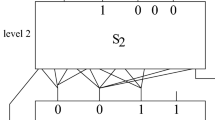Abstract
We study a fundamental result of Impagliazzo (FOCS’95) known as the hard-core set lemma. Consider any function \({f:\{0,1\}^n\to\{0,1\}}\) which is “mildly hard”, in the sense that any circuit of size s must disagree with f on at least a δ fraction of inputs. Then, the hard-core set lemma says that f must have a hard-core set H of density δ on which it is “extremely hard”, in the sense that any circuit of size \({s'=O(s/(\frac{1}{\epsilon^2}\log(\frac{1}{\epsilon\delta})))}\) must disagree with f on at least \({(1-\epsilon)/2}\) fraction of inputs from H.
There are three issues of the lemma which we would like to address: the loss of circuit size, the need of non-uniformity, and its inapplicability to a low-level complexity class. We introduce two models of hard-core set proofs, a strongly black-box one and a weakly black-box one, and show that those issues are unavoidable in such models.
First, we show that using any strongly black-box proof, one can only prove the hardness of a hard-core set for smaller circuits of size at most \({s'=O(s/(\frac{1}{\epsilon^2}\log\frac{1}{\delta}))}\) . Next, we show that any weakly black-box proof must be inherently non-uniform—to have a hard-core set for a class G of functions, we need to start from the assumption that f is hard against a non-uniform complexity class with \({\Omega(\frac{1}{\epsilon}\log|G|)}\) bits of advice. Finally, we show that weakly black-box proofs in general cannot be realized in a low-level complexity class such as AC 0[p]—the assumption that f is hard for AC 0[p] is not sufficient to guarantee the existence of a hard-core set.
Similar content being viewed by others
References
Noga Alon & Joel H. Spencer (2000). The Probabilistic Method. Wiley, New York, 2nd edition.
Babai László, Fortnow Lance, Nisan Noam, Wigderson Avi (1993) BPP has subexponential time simulations unless EXPTIME has publishable proofs. Computational Complexity 3(4): 307–318
Boaz Barak, Moritz Hardt & Satyen Kale (2009). The uniform hardcore lemma via approximate Bregman projections. In Proceedings of the 20th Annual ACM-SIAM Symposium on Discrete Algorithms, 1193–1200.
Freund Yoav (1995) Boosting a Weak Learning Algorithm by Majority. Information and Computation 121(2): 256–285
Goldmann Mikael, Hastad Johan, Razborov Alexander A. (1992) Majority Gates VS. General Weighted Threshold Gates. Computational Complexity 2: 277–300
Hajnal Andras, Maass Wolfgang, Pudlak Pavel, Szegedy Mario, Turan Gyorgy (1993) Threshold Circuits of Bounded Depth. Journal of Computer System Sciences 46(2): 129–154
Healy Alexander, Salil Vadhan P., Viola Emanuele (2006) Using Nondeterminism to Amplify Hardness. SIAM Journal of Computing 35(4): 903–931
Thomas Holenstein (2005). Key agreement from weak bit agreement. In Proceedings of the 37th ACM Symposium on Theory of Computing, 664–673.
Russell Impagliazzo (1995). Hard-Core Distributions for Somewhat Hard Problems. In Proceedings of the 36th Annual IEEE Symposium on Foundations of Computer Science, 538–545.
Russell Impagliazzo & Avi Wigderson (1997). P = BPP if E Requires Exponential Circuits: Derandomizing the XOR Lemma. In Proceedings of the 29th ACM Symposium on Theory of Computing, 220–229.
Klivans Adam R, Servedio Rocco A (2003) Boosting and Hard-Core Set Construction. Machine Learning 51(3): 217–238
Chi-Jen Lu, Shi-Chun Tsai & Hsin-Lung Wu (2007). On the Complexity of Hard-Core Set Constructions. In Proceedings of the 34th International Colloquium on Automata, Languages and Programming, 183–194.
Lu Chi-Jen, TsaiShi-Chun. Wu Hsin-Lung (2008) On the Complexity of Hardness Amplification. IEEE Transactions on Information Theory 54(10): 4575–4586
O’Donnell Ryan (2004) Hardness amplification within NP. Journal of Computer System Sciences 69(1): 68–94
Pisier Gilles (1981) Remarques sur un resultat non publié de B. Maurey. Seminaire Analyse fonctionnelle 1(12): 1980–1981
Ronen Shaltiel, Emanuele Viola (2008). Hardness amplification proofs require majority. In Proceedings of the 40th annual ACM symposium on Theory of computing, 589–598.
Roman Smolensky (1987). Algebraic methods in the theory of lower bounds for Boolean circuit complexity. In Proceedings of the 19th annual ACM symposium on Theory of computing, 77–82.
Sudan Madhu, Trevisan Luca, Vadhan Salil (2001) Pseudorandom generators without the XOR lemma. Journal of Computer System Sciences 62(2): 236–266
Márió Szegedy (1989). Algebraic methods in lower bounds for computational models with limited communication. Ph.D. thesis.
Jun Tarui (1991). Degree complexity of Boolean functions and its applications to relativized separations. In Proceedings of the 6th Annual IEEE Conference on Structure in Complexity Theory, 382–390.
Luca Trevisan (2003). List-Decoding Using The XOR Lemma. In Proceedings of the 44th Annual IEEE Symposium on Foundations of Computer Science, 126–135.
Luca Trevisan (2005). On uniform amplification of hardness in NP. In Proceedings of the 37th ACM Symposium on Theory of Computing, 31–38.
Turán Pál (1941) On an extremal problem in graph theory. Matematikai és Fizikai Lapok 48: 436–452
Emanuele Viola (2006). The complexity of hardness amplification and derandomization. Ph.D. thesis.
Andrew C. Yao (1982). Theory and application of trapdoor functions. In Proceedings of the 23rd Annual Symposium on Foundations of Computer Science, 80–91.
Author information
Authors and Affiliations
Corresponding author
Rights and permissions
About this article
Cite this article
Lu, CJ., Tsai, SC. & Wu, HL. Complexity of Hard-Core Set Proofs. comput. complex. 20, 145–171 (2011). https://doi.org/10.1007/s00037-011-0003-7
Received:
Published:
Issue Date:
DOI: https://doi.org/10.1007/s00037-011-0003-7




